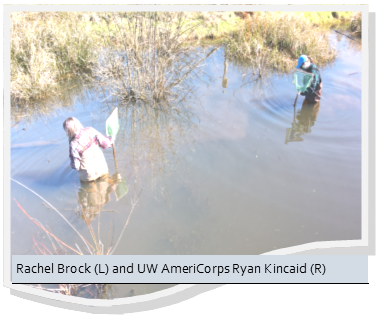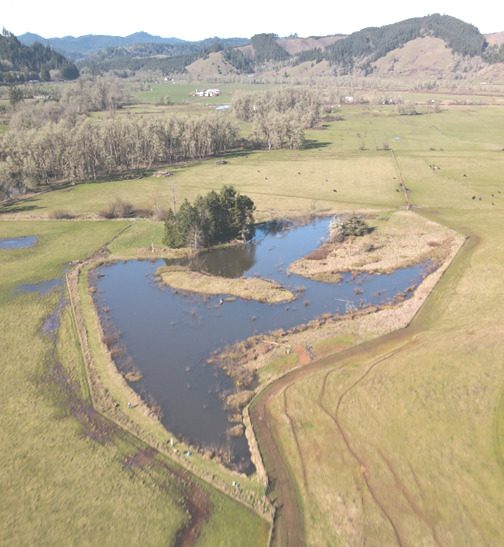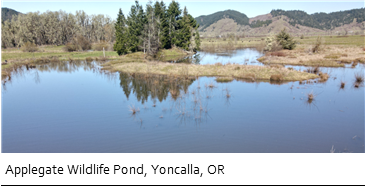Conservation and Restoration Update

 UNLSH is off and running … Janice Reid & Cindy Haws
UNLSH is off and running … Janice Reid & Cindy Haws
Umpqua Natural Leadership Science Hub (UNLSH) is a non-profit organization started by former UW Executive Director, Cindy Haws. UNLSH’s mission is to provide hands-on science learning and leadership opportunities to students and communities in Douglas County, Oregon.
Due to data gaps in life history, habitat use, relationships to hydrology, and impacts from invasive species such as bass and catfish, UNLSH has been conducting surveys of Northern Red-legged Frog (Rana aurora, NRLF) at Drew Lake in the Umpqua National Forest and Susan Applegate’s pond near Yoncalla, Oregon. Susan Applegate is a long time Umpqua Watersheds supporter and member of the Wilderness Committee.
The NRLF, a true frog, occurs from southwest British Columbia to Northern California and is protected in Oregon & California. This frog requires structurally complex ponds and wetlands both permanent and ephemeral for breeding and moist forest habitats (abundant canopy cover, downed wood and litter) below 1200m (4000 ft) elevation in a suitable spatial configuration to complete its life cycle and maintain populations. These frogs move considerable distances to and from their breeding ponds (as much as 4.8 km (3 miles) CaliforniaHerps.com, 2021). This species, like other

pond/wetland breeding amphibians, evolved a strategy to avoid predation of their offspring by depositing their eggs in what historically were fishless ponds and wetlands across the landscape. NRLFs begin mating and depositing their eggs in January (low elevation) through early March (high elevation) in the Umpqua Basin. Females can produce 200 to 1100 eggs per season, attaching the egg masses to submerged vegetation or other structures well below the pond surface.
Their adult food source consists mainly of terrestrial insects, but they will also eat small snails and crustaceans, worms, tadpoles, small fish and even small frogs of other species. The tadpoles eat periphyton (assemblages of algae and other microorganisms attached to submerged surfaces in the wetland) and are therefore important players in wetland nutrient cycling.
This frog evolved in the absence of introduced species such as bass, bullhead catfish, bluegills, and bullfrogs in their breeding ponds. Presence of these invasive non-native species in their breeding ponds along with the extensive loss & fragmentation of wetlands and forests due to urban development, agriculture, logging, and roads has caused substantial declines to NRLF populations as well as other wetland dependent species. Emerging diseases such as chytridiomycosis and climate change are exacerbating population declines. Some wetlands with these invasive species are also becoming eutrophic and therefore causing further impacts to water quality and CO2 emissions.
The purpose of the surveys conducted by UNLSH is to collect information on NRLF population conditions both before and after the removal of the invasive fish and bullfrogs to determine the efficacy of the restorative efforts. These invasive species affect not only the NRLF populations but also other pond breeding amphibians and the regions, such as the Western Pond turtle (hatchling turtles which are the size of an Oreo cookie) are susceptible to predation by these fish and bullfrogs. Strategies are being developed for elimination of the fish and possible elimination of the bullfrogs while maintaining the favorable conditions for native wetland species. Surveying for the NRLF egg masses over a period of years before and after treatment of a wetland to remove the invasive species is a relatively easy way to estimate population responses to the treatment. After several years of effort at Drew Lake Wetland we have found a positive increase in numbers of adult females. But these efforts are not easy and we need support to accomplish them. UNLSH is currently working on acquiring grants to help with equipment, supplies, and other costs associated with this conservation effort. If you would like to help, email Cindy@umpquawatersheds.org.

